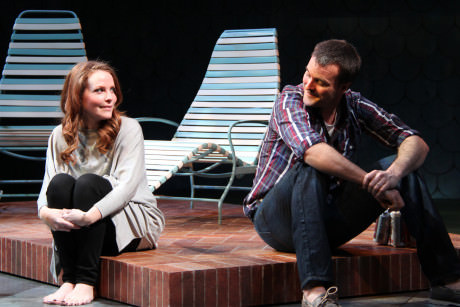I knew I would be bummed if I missed the Round House Theatre production of Gina Gionfriddo’s Rapture, Blister, Burn. Everything I read told me, “John, you gotta see this.” So when I caught its penultimate performance Saturday evening, I felt lucky indeed—not least because this was in the midst of DC’s massive snowshow, when folks all over town were shivering and theaters were shuttering—but Round House kept its home fires burning. Having seen Rapture, Blister, Burn, I can report: If any of you out there are kicking yourselves because you missed it, well, don’t hurt yourselves or anything, but I can feel your pain—because there but for a snowfluke go I.

The play was engrossing, the cast was extraordinary, Shirley Serotsky’s direction was spot on. The audience was clearly connecting, which struck me as a marvel. Given how much feminist theorizing is packed into Gionfriddo’s script—some of it densely, abstrusely academic—one might have supposed that eyes would glaze over. But no, the flurry of feminist ideas in the show played like piquant catnip to a herd of felines (among whom were not a few toms; the audience included many couples who appeared to be on a date). And these weren’t just garden-variety feminist ideas (like: women ought to have choices, it’s hard to have it all, that sort of thing). Sure, there was a lot of such duh, easy-on-the-ears opining. Yet this firebrand of a script also had a thick load of gritty stuff about pornography, a topic that typically makes its appearance in the performing arts salaciously and panderingly. But analytically and critically? Not so much.
I read the local press on the show when I came home. I was struck by how minimally the theme of pornography in the play was mentioned. Mainly the theme written about was the “Can women have it all?” question. The play certainly warrants that discussion. The central story line is built on the tension between two former college roommates: Catherine, now a single woman prominent in her career, and Gwen, a stay-at-home mom. As it happens, Gwen’s husband, Don, was Catherine’s boyfriend back in the day, and so when Catherine comes to visit, she and Don find laboratory conditions for their sexual chemistry to reignite.
What actually stirs the pot of tension in the play between a woman who chose career and a woman who chose family however is not therefore exactly the feminist dilemma that Betty Friedan broached in The Feminine Mystique. The conflict turns out to be about (wait for it:) a dude. The plot of Rapture, Blister, Burn, at least on the face of it, turns on the turn-on of adultery, perhaps commercial theater’s most all-time favorite, and most tiresome, trope. As a consequence a lot of the dialogue between Catherine and Gwen—between whom one might expect fiery feminist ideas to flare—doesn’t actually pass the Bechdel test. There’s this guy between them, see? And he takes up air in the room even when he’s not there.
The big twist in Rapture, Blister, Burn, however—the point where Gionfriddo blows the adultery trope to pieces—is her character of the dude. She establishes Don as being not only ambitionless and a pothead but also addicted to watching online pornography in the basement—a habit that, as Gionfriddo makes clear, has had a flat-lining effect in his and Gwen’s bedroom.
Given how many men are similarly hooked on virtual hookups with virtual hookers, and given how many sexual relationships are similarly going south as a result, one might expect a pornography-addiction backstory like Don’s to be showing up more often on stage (as it did, for instance, in last summer’s brilliant Capital Fringe hit Giant Box of Porn, by Patrick Flynn).
Gionfriddo’s fresh take here is that Don is no catch, not even a lothario. He’s a pathetic loser according to his wife (on account of his trifecta of defects: his slacking, his toking, and his stroking), and she has stuck with him ’cause of the kids. The genius of Gionfriddo’s script is that, going where few playwrights of any gender have gone, she has nervily made Don the porn addict the pivot of her play. And suddenly with Catherine, who’s a feminist fury of sorts, Don is like a phoenix arousing after doing it one handed so long to fantasy tits and asses.
If that isn’t a combustible setup for a bonfire of a play, I don’t know what is.
So why has so much commentary about Rapture, Blister, Burn kept mum about the centrality of internet pornography in Gionfriddo’s script? Reviewers have glommed onto the “having it all” question and seemed to skitter around the elephant-in-the-room issue. Is it that the topic of what pornography is doing to men’s sexuality, in real time and in real life, is now as taboo as pornography itself once was?
One can find plenty on line about pornography’s suppressant effect on men’s capacity for empathic eroticism with living partners. For instance, there’s a site targeted to young people—the generation who grew up in a culture steeped in internet pornography—called Fight the New Drug. It has almost nothing that sounds anything like feminist theorizing about pornography. It’s all about the basic damage that, as young people are learning, pornography has done to their sexuality and their relationships—something second wave feminists never really saw coming—with advice and inspiration for those who want to recover.
Of Gionfriddo’s initial impulse to write Rapture, Blister, Burn, she has said:
I actually set out to write a play about the impact of Internet pornography on the American psyche. I had a pre-Internet childhood. When we became curious about sex, we had to work so hard for every little scrap of information. Now it’s just, as one of my characters says, point-and-click to see full penetration online. So I went chasing after some wisdom about how this colossal change in access to porn has impacted us.
Though the play Gionfriddo ended up writing doesn’t announce itself as being about the effects of internet pornography, that theme is organically embedded throughout, not only in the character Don and his storylines with Gwen and Catherine but also in all the discourse about feminist viewpoints on pornography. The play is chockablock with chatter about the theme, in fact. The wonderfully frank character Avery, a millennial who comes into the play as Gwen and Don’s babysitter, has some particularly sharp-edged observations about her generation’s experience of internet pornography. You can’t listen to the play without the theme of pornography, and internet pornography in particular, jumping out at you.

House Theatre’s current production of ‘Rapture, Blister, Burn.’ Photo by Danisha Crosby.
As I sat there Saturday night, I found myself mentally applauding the play’s complex and near-constant engagement with the theme. Even though I didn’t agree with everything every character said, I realized that wasn’t the point. This wasn’t really about contested feminist arguments about pornography. This was a hard look at the inarguable deleterious effects of the stuff itself—artfully and fully embodied, as every big theme in theater must be, in character and action. And I was enraptured by the play’s blistering and burning engagement with the topic.
So it was that afterward I found the local media’s relative silence about the theme…curious.
Was everyone just snowed?
Running Time: Approximately two hours, with one 15-minute intermission.
Rapture, Blister, Burn ended its run yesterday, February 22, 2015 at Round House Theatre – 4545 East-West Highway, in Bethesda, MD. For tickets for their upcoming shows and events, call the box office at (240) 644-1100, or purchase them online.
LINK
‘Rapture, Blister, Burn’ at Round House Theatre reviewed by Gina Jun on DCMetroTheaterArts.




